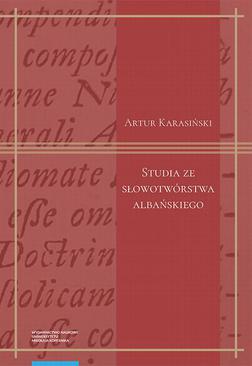
A comparative study of word-formation in Balkan languages
4,6
- Autorzy:
Anna Cychnerska ,
Viara Maldjieva ,
Artur Karasiński
- Wydawnictwo:
Wydawnictwo Naukowe Uniwersytetu Mikołaja Kopernika
- ISBN:9788323143376
- Format:PDF
40,94 zł
Introduction / 9
A. General issues (Viara Maldjieva)
Chapter I
A model for a comparative study of word-formation in Balkan languages / 13
1. A comparative study of word-formation / 13
2. The basic concepts of the description / 15
3. Basic assumptions of the model of a comparative description of word-formation / 20
3.1. General assumptions / 20
3.2. Specific assumptions / 22
Chapter II
Semantic properties of derivatives in Balkan languages / 27
1. Semantic derivation / 27
2. Semantic structure of derivatives. Derivational meaning / 33
2.1. Lexical meaning and derivational meaning of a derived lexeme / 33
2.2. Components of the semantic structure of a derivative / 35
2.3. Derivational paraphrase / 42
3. Types of meaning relations between the concepts in the semantic structure of derived words. Derivational categories / 44
3.0. Derivational category / 44
3.1. Argument categories / 46
3.2. Argument categories in structures with an unexpressed predicate / 52
3.3. Predicative categories / 59
3.4. Summary / 76
Chapter III
Formal and functional properties of derivatives in Balkan languages / 79
1. Formal properties of derivatives / 79
1.1. Synchronic derivational division / 79
1.2. Types of base / 83
1.3. Types of formant / 86
1.4. Variation of bases and formants / 92
1.5. Distribution of formants / 96
1.6. The formal structure of derivatives / 97
2. Functional properties of formants / 104
2.1. Functions of formants in the structure of derivatives / 104
2.2. Formants with semantic function – exponents of derivational categories / 105
2.3. Homonymy and polyfunctionality of formants / 105
B. The detailed analysis (Viara Maldjieva, Anna Cychnerska, Artur Karasiński, Tomasz Cychnerski)
Chapter I
Argument categories / 117
1. Bulgarian (V. Maldjieva) / 118
2. Macedonian (A. Cychnerska) / 149
3. Serbian (A. Cychnerska) / 177
4. Albanian (A. Karasiński) / 208
5. Romanian (T. Cychnerski) / 227
6. Summary (V. Maldjieva) / 245
Chapter II
Structures with an unexpressed predicate / 249
1. Bulgarian (V. Maldjieva) / 250
2. Macedonian (A. Cychnerska) / 252
3. Serbian (A. Cychnerska) / 255
4. Albanian (A. Karasiński) / 258
5. Romanian (T. Cychnerski) / 261
6. Summary (V. Maldjieva) / 263
Chapter III
Predicative categories / 265
1. Bulgarian (V. Maldjieva) / 265
2. Macedonian (A. Cychnerska) / 319
3. Serbian (A. Cychnerska) / 371
4. Albanian (A. Karasiński) / 432
5. Romanian (T. Cychnerski) / 453
6. Summary (V. Maldjieva) / 480
Chapter IV
Variation of formants / 483
1. Bulgarian (V. Maldjieva) / 484
2. Macedonian (A. Cychnerska) / 488
3. Serbian (A. Cychnerska) / 494
4. Albanian (A. Karasiński) / 500
5. Romanian (T. Cychnerski) / 503
6. Summary (V. Maldjieva) / 506
Chapter V
The distribution, homonymy, and polyfunctionality of formants / 507
1. Bulgarian (V. Maldjieva) / 508
2. Macedonian (A. Cychnerska) / 526
3. Serbian (A. Cychnerska) / 542
4. Albanian (A. Karasiński) / 560
5. Romanian (T. Cychnerski) / 567
6. Summary (V. Maldjieva) / 575
Chapter VI
Formal structures of single-stem derivatives / 579
1. Bulgarian (V. Maldjieva) / 580
2. Macedonian (A. Cychnerska) / 581
3. Serbian (A. Cychnerska) / 583
4. Albanian (A. Karasiński) / 585
5. Romanian (T. Cychnerski) / 587
6. Summary (V. Maldjieva) / 589
Conclusion / 591
References / 593


